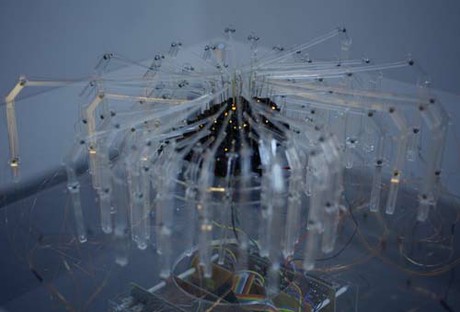THE BEAUTY OF A FLOWER, Hanna Schraffenberger
Do you have to be a scientist in order to like this? Staring at Philip Beesley's 'Protocell Field', I wonder whether I would appreciate it more, if I'd understand the organic processes going on inside. The flowery work reminds me of an interview with the physicist Richard Feynman. In the interview, Feynman tells us about a disagreement with a friend. The friend is an artist and claims that Feynman is unable to appreciate the beauty of a flower because he is a scientist. According to the artist, science transforms the beautiful flower into a dull thing by taking it apart. The physicist disagrees and points out the “beauty of the smaller dimension, the inner structure”. He explains how he can appreciate even more about the flower than his friend — for example “the complicated actions inside which also have a beauty”.
At DEAF's exhibition it becomes clear, that such inner beauty is no longer reserved for scientists. Artists have adopted the scientific view and discovered the power of the smaller dimension. It's those complicated actions inside which they create, design or deploy. DEAF calls it vital beauty and it's up to us — the laymen visitors — to appreciate it.
The smaller dimension
Being a huge fan of Malevich's Black Square from 1915, I didn't expect to ever be impressed by someone else's black squares again. However, 'Hostage pt. 1' by Frederik de Wilde does the trick. Strictly speaking, this piece is about what you don't see. The black material used is completely nano engineered and reflects less light than any other black. That makes this 'Hostage pt. 1' the darkest artwork in the word. Besides being almost invisible, the technology used also has practical applications. The carbon-nanotubes transform light into heat - a process useful for solar panels. The work does not only make me wonder "How black can black be?" but also makes me question perception: what's the blackest black that we can see? Does this square allow me to perceive blacker black than when closing my eyes in a dark room?
Complicated actions inside
The exhibition seems fond of extremes. After having seen the darkest of all blacks, I get all dressed up in a warming white coat to see 'Sealed'. It may not be the coolest piece of art history, but its definitely the coldest piece I have seen. The work combines a 10 kg solid salt crystal with a 1000 kg block of ice. The combination is locked up in an extremely cold room. Over the next days, the ice will slowly melt and the two substances will mix. When I enter the room, the process has already begun. However, it's so slow that all I can see seems like a snapshot in time.
Crystals are also the basis of 'Irrational Computing'. The installation consists of five parts that are set up in a dark room. Each part has the approximate size of a kitchen plate — an electronic five course dinner, all courses served at once. My favorite part looks like a spider with hundreds of transparent crystal legs. Another part is made up of a bed of crystals that look like sawdust salt. The crystals are essentially the same material as used in information technology. Usually, such crystals have to function according to strict rules. In this piece however, they are allowed to act out and behave unpredictably. One can't really see the small-scale processes which go on inside. However, we can hear the resulting rattling sounds and see its flickering lights.

Leaving the exhibition, I am sure one doesn’t have to be a scientist in order to enjoy it. However, I still wonder how much hidden beauty I have missed. Was I able to appreciate the inner processes and complicated actions inside? I feel like I have been looking at the surficial beauty of the flower instead.


